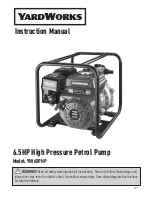
Cetetherm Midi Wall IQHeat
Installation, service and operating instruction
7
3
Installation
3.1
Unpacking
•
Remove the transport packaging and check that the product has not been damaged in transit and that
the consignment agrees with the specifications.
•
When lifting the unit, take care not to apply stress to pipes and heat exchangers as this may weaken
them Lift the unit in the frame; avoid lifting the unit by holding the heat exchangers. Use pallet lift where
applicable, if using back straps these should be attached to the substructure of the substation.
NOTE
: Risk of injury lifting heavy objects.
3.2
Preparation
•
Choose a suitable installation area in accordance with official regulations.
The system may generate sounds during operation caused by pumps, regulators systems, flows etc.
This should be taken into consideration during installation of the unit, so that possible operational
sounds affect the surroundings as little as possible. This means that the system should be installed on
well-insulated walls, such as outer walls or on concrete walls.
•
Check the applicable regulations of the district heating supplier. The available differential pressure
should be at least 100 kPa and at most 600 kPa. Where the differential pressure is higher, a differential
pressure controller should be added to the installation.
•
Flush heating and hot water systems.
3.3
Mounting
•
Mount the substation on a wall with screws and bolts suitable for mounting wall material and substation
weight. The distance between floor and screw bracket should be 1420 mm. Note that distance between
screws are 400 mm. Mount the floor support on the central, use the middle mounting hole. Raise the
central and mount it on the wall.
•
Place the substation so that connections, adjustment equipment and safety valves are easily
accessible.
•
Mount the shutoff valves on district heating supply and return. Shutoff valves are not supplied.
•
Connect the pipe works to the connection points, see
•
When executing hot work on or close by the substation, all incendiary components should be
demounted and removed.
•
With supply temperatures above 100°, it is recommended that the actuator is tilted or closed down, see
•
Take rules and instructions regarding hot work into account.
•
Connecting pipes shall be suspended so that their weight does not stress the unit.
•
All connecting pipes within and connecting to the units
’ system shall be insulated according to
standards and regulations.
•
Drainage pipes from safety valves must be taken to floor gully.
•
Energy meters must be installed at a prepared location, replacing a gauge block, or following the
instructions of the energy supplier.
NOTE:
the connection pipe between the valves is just for draining.
•
Retighten all connections, including those made at the factory. If connections need retightening after
the installation has been taken into service, the system should be depressurised before retightening.
If
the system is not depressurised before retightening, gaskets will be damaged.
•
Required expansion volume shall be installed and provided with adequate pre-charge before start up.
•
Remount plugs in drain valves after possible draining of circuit.










































